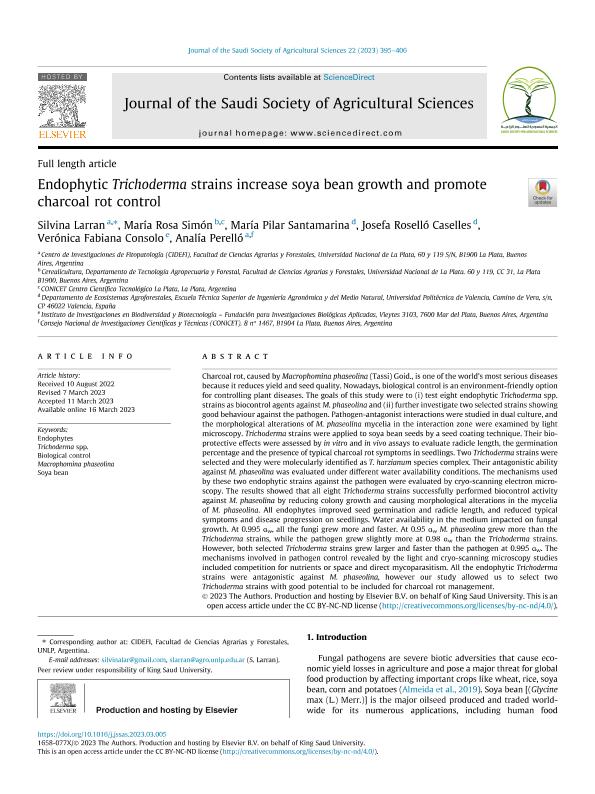Mostrar el registro sencillo del ítem
dc.contributor.author
Larran, Silvina

dc.contributor.author
Simon, Maria Rosa

dc.contributor.author
Santamarina, María Pilar
dc.contributor.author
Roselló Caselles, Josefa
dc.contributor.author
Consolo, Verónica Fabiana

dc.contributor.author
Perello, Analia Edith

dc.date.available
2023-12-29T15:45:46Z
dc.date.issued
2023-03
dc.identifier.citation
Larran, Silvina; Simon, Maria Rosa; Santamarina, María Pilar; Roselló Caselles, Josefa; Consolo, Verónica Fabiana; et al.; Endophytic Trichoderma strains increase soya bean growth and promote charcoal rot control; Elsevier; Journal of the Saudi Society of Agricultural Sciences; 22; 7; 3-2023; 395-406
dc.identifier.issn
1658-077X
dc.identifier.uri
http://hdl.handle.net/11336/221912
dc.description.abstract
Charcoal rot, caused by Macrophomina phaseolina (Tassi) Goid., is one of the world's most serious diseases because it reduces yield and seed quality. Nowadays, biological control is an environment-friendly option for controlling plant diseases. The goals of this study were to (i) test eight endophytic Trichoderma spp. strains as biocontrol agents against M. phaseolina and (ii) further investigate two selected strains showing good behaviour against the pathogen. Pathogen-antagonist interactions were studied in dual culture, and the morphological alterations of M. phaseolina mycelia in the interaction zone were examined by light microscopy. Trichoderma strains were applied to soya bean seeds by a seed coating technique. Their bioprotective effects were assessed by in vitro and in vivo assays to evaluate radicle length, the germination percentage and the presence of typical charcoal rot symptoms in seedlings. Two Trichoderma strains were selected and they were molecularly identified as T. harzianum species complex. Their antagonistic ability against M. phaseolina was evaluated under different water availability conditions. The mechanisms used by these two endophytic strains against the pathogen were evaluated by cryo-scanning electron microscopy. The results showed that all eight Trichoderma strains successfully performed biocontrol activity against M. phaseolina by reducing colony growth and causing morphological alterations in the mycelia of M. phaseolina. All endophytes improved seed germination and radicle length, and reduced typical symptoms and disease progression on seedlings. Water availability in the medium impacted on fungal growth. At 0.995 ɑw, all the fungi grew more and faster. At 0.95 ɑw M. phaseolina grew more than the Trichoderma strains, while the pathogen grew slightly more at 0.98 ɑw than the Trichoderma strains. However, both selected Trichoderma strains grew larger and faster than the pathogen at 0.995 ɑw. The mechanisms involved in pathogen control revealed by the light and cryo-scanning microscopy studies included competition for nutrients or space and direct mycoparasitism. All the endophytic Trichoderma strains were antagonistic against M. phaseolina, however our study allowed us to select two Trichoderma strains with good potential to be included for charcoal rot management.
dc.format
application/pdf
dc.language.iso
eng
dc.publisher
Elsevier

dc.rights
info:eu-repo/semantics/openAccess
dc.rights.uri
https://creativecommons.org/licenses/by-nc-nd/2.5/ar/
dc.subject
BIOLOGICAL CONTROL
dc.subject
ENDOPHYTES
dc.subject
MACROPHOMINA PHASEOLINA
dc.subject
SOYA BEAN
dc.subject
TRICHODERMA SPP.
dc.subject.classification
Agronomía, reproducción y protección de plantas

dc.subject.classification
Agricultura, Silvicultura y Pesca

dc.subject.classification
CIENCIAS AGRÍCOLAS

dc.title
Endophytic Trichoderma strains increase soya bean growth and promote charcoal rot control
dc.type
info:eu-repo/semantics/article
dc.type
info:ar-repo/semantics/artículo
dc.type
info:eu-repo/semantics/publishedVersion
dc.date.updated
2023-12-27T17:45:20Z
dc.journal.volume
22
dc.journal.number
7
dc.journal.pagination
395-406
dc.journal.pais
Países Bajos

dc.journal.ciudad
Amsterdam
dc.description.fil
Fil: Larran, Silvina. Universidad Nacional de La Plata. Facultad de Ciencias Agrarias y Forestales. Departamento de Ciencias Biológicas. Centro de Investigaciones de Fitopatología. Provincia de Buenos Aires. Gobernación. Comisión de Investigaciones Científicas. Centro de Investigaciones de Fitopatología; Argentina
dc.description.fil
Fil: Simon, Maria Rosa. Consejo Nacional de Investigaciones Científicas y Técnicas. Centro Científico Tecnológico Conicet - La Plata; Argentina. Universidad Nacional de La Plata. Facultad de Ciencias Agrarias y Forestales. Cátedra de Cerealicultura; Argentina
dc.description.fil
Fil: Santamarina, María Pilar. Universidad Politécnica de Valencia; España
dc.description.fil
Fil: Roselló Caselles, Josefa. Universidad Politécnica de Valencia; España
dc.description.fil
Fil: Consolo, Verónica Fabiana. Consejo Nacional de Investigaciones Científicas y Técnicas. Centro Científico Tecnológico Conicet - Mar del Plata. Instituto de Investigaciones en Biodiversidad y Biotecnología; Argentina. Fundación para Investigaciones Biológicas Aplicadas. Centro de Estudios de Biodiversidad y Biotecnología; Argentina
dc.description.fil
Fil: Perello, Analia Edith. Consejo Nacional de Investigaciones Científicas y Técnicas. Centro Científico Tecnológico Conicet - La Plata; Argentina. Universidad Nacional de La Plata. Facultad de Ciencias Agrarias y Forestales. Departamento de Ciencias Biológicas. Centro de Investigaciones de Fitopatología. Provincia de Buenos Aires. Gobernación. Comisión de Investigaciones Científicas. Centro de Investigaciones de Fitopatología; Argentina
dc.journal.title
Journal of the Saudi Society of Agricultural Sciences
dc.relation.alternativeid
info:eu-repo/semantics/altIdentifier/doi/http://dx.doi.org/10.1016/j.jssas.2023.03.005
dc.relation.alternativeid
info:eu-repo/semantics/altIdentifier/url/https://www.sciencedirect.com/science/article/pii/S1658077X23000346
Archivos asociados
